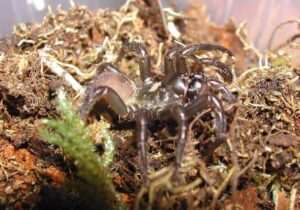About Theraphosidae
Theraphosidae is the scientific name for the family of spiders known as ”tarantulas” and they belong to the infraorder Mygalomorphae. Other families are for example trapdoor spiders (Dipluridae), funnel web spiders (Hexathelidae) and purseweb spiders, Atypidae – Swedens only mygalomorph spider, Atypus affinis, belong to this family.

What differentiate the mygalomorph from the areanomorph (sometimes refered to as ”true spiders”) is among other things how the jaws, chelicera, are located and how they move.
On a mygalomorph spider the chelicera are located parallell to each other and move up and down, while in areanomorphs the chelicera are located opposite to each other and move toward each other. There are more differencies but the chelicera are perhaps the easiest way to see the difference between the two groups.


The number of described species are 1,047 in 156 genera (december 2022) and new species are found and described each year. The size varies a lot, from c:a 2 cm to 10 cm in body length.

Theraphosids are found in North America, in the West and South West, further east to the Mississippi River in the US, south through out Mexico, the entire Central- and South America. In Europe a few species can be found in Portugal, south of Spain, Italy, Greece and Cyprus. They are found over the entire African continent (most likely not in the Sahara desert region). From Turkey across the arabic peninsular, India, entire South East Asia to Hong Kong, up toward south China, New Guinea and Australia.
